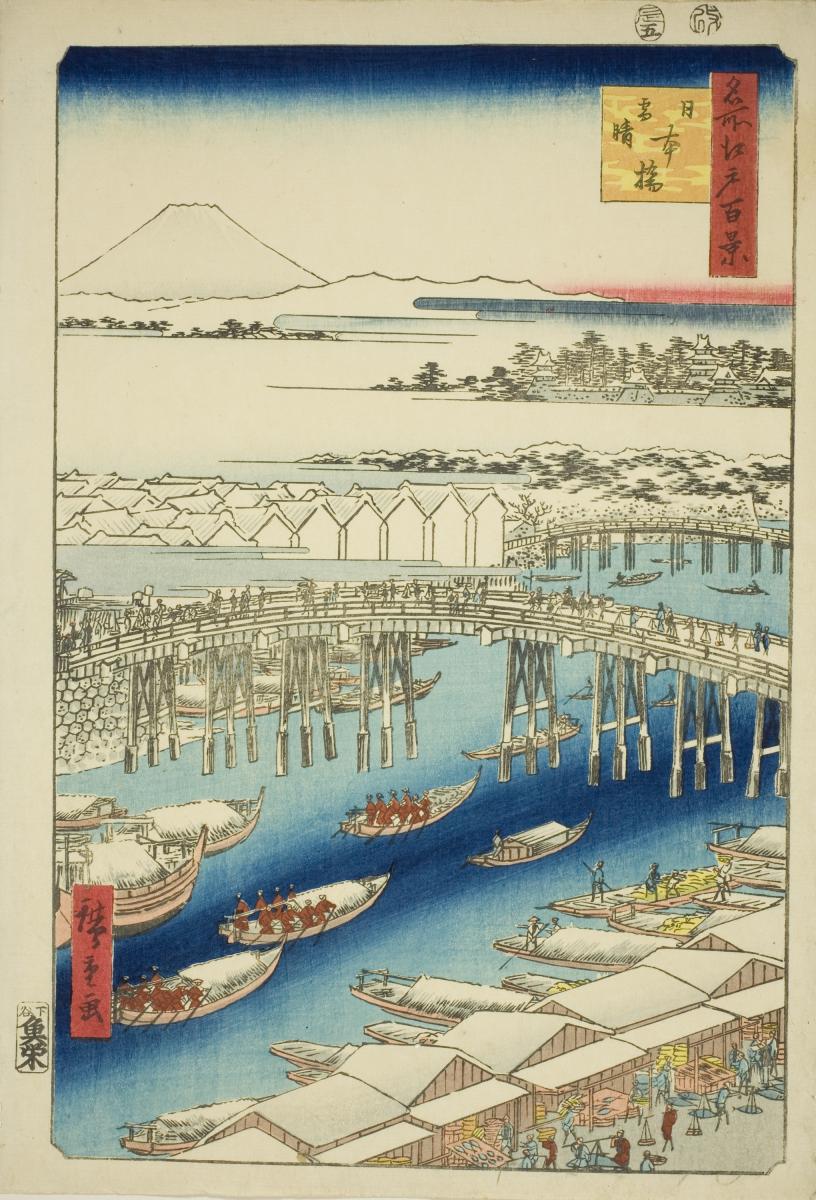This wonderful Cornish workshop and museum is dedicated to the legacy of studio pottery trailblazer Bernard Leach
Instant Expert: Hiroshige’s Clear Weather After Snow at Nihonbashi Bridge
Instant Expert: Hiroshige’s Clear Weather After Snow at Nihonbashi Bridge
20 Sep 2021
This beautiful print was once the price of a takeaway snack; now a museum piece, it features in a show about Tokyo at the Ashmolean. Curator Dr Clare Pollard reveals its story

Clear Weather After Snow at Nihonbashi Bridge, a colour woodblock print designed by Utagawa Hiroshige I in 1856
This vibrant view of Edo (modern-day Tokyo) is by Utagawa Hiroshige. Hiroshige was one of Japan’s greatest woodblock print designers. Born in 1797 in Edo, he was prolific, creating over 4,000 print designs over almost 50 years. His subjects included beautiful women, kabuki actors and bird-and-flower studies, but he is best known for his landscape prints, which capture brilliantly the effects of season, weather and time of day.
By Hiroshige’s day the Japanese print industry was booming
Woodblock prints like this were the price of a large bowl of noodles. They were known as ukiyo-e, or ‘pictures of the floating world’, a term that referred to the fleeting pleasures of the entertainment districts in the city. The majority depicted courtesans and kabuki actors; the landscape print was a relatively new genre, pioneered by Hiroshige’s contemporary Hokusai in the early 19th century. The title of this series can be seen in the red cartouche in the top right corner: One Hundred Famous Views of Edo. This set was published in instalments during the final years of Hiroshige’s life. It showed many of the city’s ‘famous places’, known through history, poetry and literature, and also less well-known sites, such as shops and teahouses. The series was so successful that after he died in 1858, his pupil and son-in-law, Hiroshige II (1829–69), completed the set of 118 views.
This print was the first to be published
It sets the scene for the entire series in the way it juxtaposes the grandeur of nature, weather and the seasons with everyday activities. It is a bright morning and a magnificent Mount Fuji, disproportionately large, rises serenely over a bustling scene. At the centre is Nihonbashi, the ‘Bridge of Japan’. Built in 1603, this was the official point from which distances to all parts of Japan were measured. On the river, fishing boats carry their catch to the market shown to the fore. On the far side of the bridge stand white-painted storehouses, again exaggerated in size, perhaps to emphasise the wealth of the city under its benevolent military rulers. Crossing the print at intervals are bands of pale grey clouds, a device used to separate areas and indicate distance. Far away to the right is Edo Castle, shown as a powerful presence overseeing the city below.
'Hiroshige creates depth without using European- style perspective, while the cropping of objects at the edges draws the viewer in'
Although this print is Hiroshige’s vision...
...and his signature is bottom left, he was simply the designer, working in a team of craftsmen employed by a publisher, together with a woodblock carver and a printer. The print has a limited palette of bright blues and soft red, grey and brown. Particularly striking is the vivid blue of the river and the sky, for which Hiroshige took advantage of the new European pigment Prussian blue. Although far from realistic, the colours evoke the crisp light of a bright winter’s morning.
Hiroshige layers elements within the picture frame
See the fish market in the foreground, the bridge behind it, the storehouses and the abstract cloud bands beyond – Hiroshige creates depth without using European- style perspective, while the cropping of objects at the edges draws the viewer in. Hiroshige’s bold compositions and his use of strong, flat colour made an impression on late-19th-century European avant-garde artists; they were inspired by the freedom Japanese prints offered from imitative or photographic representation. Hiroshige’s landscapes were collected by artists including Manet, Monet, Degas, Whistler and Van Gogh, who famously copied two designs from the series in oils.
SEE
Tokyo: Art & Photography, until 3 January 2022, Ashmolean Museum, Oxford; ashmolean.org
About the Author
Dr Clare Pollard
Dr Clare Pollard is Curator of Japanese Art at the Ashmolean Museum
JOIN OUR MAILING LIST
Become an instant expert!
Find out more about the arts by becoming a Supporter of The Arts Society.
For just £20 a year you will receive invitations to exclusive member events and courses, special offers and concessions, our regular newsletter and our beautiful arts magazine, full of news, views, events and artist profiles.
FIND YOUR NEAREST SOCIETY
MORE FEATURES
Ever wanted to write a crime novel? As Britain’s annual crime writing festival opens, we uncover some top leads
It’s just 10 days until the Summer Olympic Games open in Paris. To mark the moment, Simon Inglis reveals how art and design play a key part in this, the world’s most spectacular multi-sport competition



